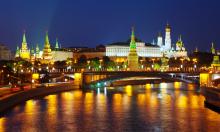The Day first man in space died ironic death
35 years ago today, the world heard the tragic news of the death of the first man in space, Soviet cosmonaut Yuri Gagarin.
It happened on March 27, 1968, near the village of Novoselovo in the Vladimir Region, northeast of Moscow. Gagarin was conducting a training flight with his pilot instructor Vladimir Seryogin. Both men were highly experienced pilots honored with the gold star of the Hero of the Soviet Union.
To answer the question of the causes of their death, all the facts available would have to be carefully put together and analyzed. However, none of this was done back in 1968.
After a hasty inquiry, a government commission returned the verdict that the Mig 15 UTI airplane Gagarin and Seryogin had flown went into a spin during a zone flight, never to start the normal flight again.
Much of the relevant data for the inquiry was lacking, while some facts were not looked at hard enough. Different theories were suggested, from an explosion in the air to depressurization of the cockpit to a foreign object in the engine. The commission's findings and the subsequent official conclusion did not seem convincing enough, giving rise to a host of rumors and legends, some totally fantastic, some quite plausible.
One of the more popular theories put the pilots' death down to sabotage. The implication was that Gagarin had supposedly fallen out of favor with the top of the ruling party and tried to use his rights of a member of the rubberstamp Soviet legislature to confront the regime.
The next most popular theory was that Gagarin was drunk at the time of the flight. This meant he lost control of the plane, while instructor Seryogin suffered complete kidney failure at a critical point. It was claimed that a medical forensic test had corroborated this by revealing alcohol in Gagarin's body.
Then there was the legend that after making the world's first space flight Gagarin had traveled the world a lot and was recruited to spy for a western country at some point. After he then felt he was being followed and realized he had had his cover blown, he was said to have resolved to commit suicide, thus retaining his first cosmonaut fame. The training flight, this theory goes, was an opportunity for him to carry out this plan.
More bizarre rumors went round. One rumor had it that a UFO was in the area where Gagarin and Seryogin were flying. Alien mind control paralyzed the crew and caused the plane to lose control.
Known Bulgarian psychic Vanga claimed Gagarin was alive and in hiding in the United States.
In the mid-eighties, stories began to appear in the press featuring the views of members of the government commission, scientists, the military, and witnesses to the accident. Among these public figures were Professor Sergei Belotserkovsky, whose honors included a degree in engineering and the State Prize of the USSR, andCosmonaut Alexei Leonov.
More than 16 years after the crash, Belotserkovsky pursued an in-depth study of the causes of Gagarin and Seryogin's death. Several years in length, the effort brought together numerous scientists, pilots and volunteers keen to help solve the problem and involved advanced computer modeling and unique experiments.
The author of the study maintains the factor that may have affected Gagarin and Seryogin's flight may be manifold. While not dangerous individually, they may have combined to become lethal for the crew.
Belotserkovsky rejects the theories that the plane may have been faulty or the pilots may have been ill-prepared for the mission. Equally denied are theories that the plane collided with an atmospheric probe, a flock of birds and similar, thus repudiating the essential findings of the official enquiry.
What he feels was the main reason why the plane lost control is that it came dangerously close to another plane, which was on a test flight in the adjoining zone, following repairs. When 625 - Gagarin's call sign - was caught into the jet from the plane in front is the point where it went into a spin.
Poor visibility in the clouds meant the pilots' situation was difficult, but they tried to take the plane out of the spin nevertheless. Their actions were competent and the only right ones in the circumstances, but then a meteorological service error meant they emerged from the clouds at a lower height than expected. The pilots did all they could to save themselves and the plane, but they came 250-300 meters short of the height necessary, Belotserkovsky claims.
Culpability for the deaths of Gagarin and special air regiment commander Seryogin lies with the pilot of the other airplane, a Sukhoi 11, who failed in his brief for the flight, alleged cosmonaut Leonov at a press conference in Moscow's Central House of Journalists on March 24, 2003. The event was timed to coincide with the anniversary of the death of the world's first cosmonaut.
Many experts, including veteran test pilot Lt. Gen. Stepan Mikoyan and cosmonaut Viktor Gorbatko, challenged Leonov's conclusions. Their theory was that Gagarin and Seryogin's plane crashed into a probe.
Experts still differ over the causes of the air crash near the Vladimir Region village of Novoselovo. But increasingly, it looks like we may never really know. Where all the experts do concur is the first man in space died a bitterly ironic death.
"There can be many theories of Gagarin's death, but the one conclusion is that 35 years now we can't get to grips with the irreparable loss," said Gorbatko, a member of the same cosmonaut squad as Gagarin.
Gagarin had turned 34 shortly before his death. He made his one legendary space flight on April 12, 1961, circling the Earth in 108 minutes.
Subscribe to Pravda.Ru Telegram channel, Facebook, RSS!




